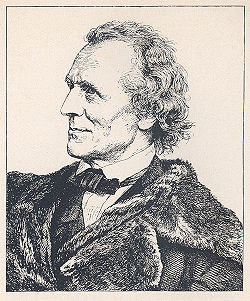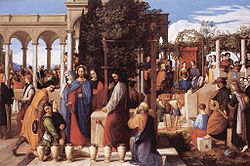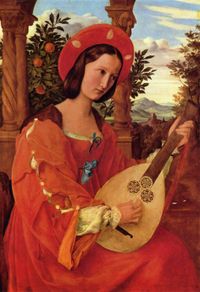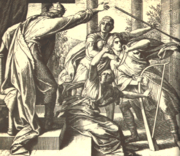
Julius Schnorr von Carolsfeld
Encyclopedia


Painting
Painting is the practice of applying paint, pigment, color or other medium to a surface . The application of the medium is commonly applied to the base with a brush but other objects can be used. In art, the term painting describes both the act and the result of the action. However, painting is...
.
Biography
Schnorr was born at Leipzig, where he received his earliest instruction from his father Johann Veit Schnorr (1764–1841), a draughtsman, engraver and painter. At seventeen he entered the Vienna Academy, from which Johann Friedrich OverbeckJohann Friedrich Overbeck
Johann Friedrich Overbeck , was a German painter and member of the Nazarene movement. He also made four etchings.-Biography:...
and others who rebelled against the old conventional style had been expelled about a year before.
In 1815 he followed the founders of the new artistic brotherhood, the Nazarene movement
Nazarene movement
The name Nazarene was adopted by a group of early 19th century German Romantic painters who aimed to revive honesty and spirituality in Christian art...
in their pilgrimage to Rome. This school of religious and romantic art abjured modern styles and reverted to and revived the principles and practice of earlier periods. At the outset an effort was made to recover fresco
Fresco
Fresco is any of several related mural painting types, executed on plaster on walls or ceilings. The word fresco comes from the Greek word affresca which derives from the Latin word for "fresh". Frescoes first developed in the ancient world and continued to be popular through the Renaissance...
painting and monumental art, and Schnorr found opportunity of proving his powers, when commissioned to decorate with frescoes, illustrative of Ariosto, the entrance hail of the Villa Massimo
Villa Massimo
Villa Massimo, short for Deutsche Akademie Rom Villa Massimo , is a German art institute in Rome, established in 1910 and located in the Villa Massimo....
, near the Lateran
Lateran
Lateran and Laterano are the shared names of several architectural projects throughout Rome. The properties were once owned by the Lateranus family of the former Roman Empire...
. His fellow-laborers were Cornelius
Peter von Cornelius
Peter von Cornelius was a German painter.Cornelius was born in Düsseldorf.His father, who was inspector of the Düsseldorf gallery, died in 1799, and the young Cornelius was stimulated to extraordinary exertions...
, Overbeck and Veit
Philipp Veit
Philipp Veit was a German Romantic painter. To Veit is due the credit of having been the first to revive the almost forgotten technique of fresco painting.- Biography :Veit was born in Berlin, Prussia...
.
His second period dates from 1825, when he left Rome, settled in Munich, entered the service of King Ludwig
Ludwig I of Bavaria
Ludwig I was a German king of Bavaria from 1825 until the 1848 revolutions in the German states.-Crown prince:...
, and transplanted to Germany the art of wall-painting learned in Italy. He showed himself qualified as a sort of poet-painter to the Bavarian court; he organized a staff of trained executants, and set about clothing five halls in the new palace with frescoes illustrative of the Nibelungenlied
Nibelungenlied
The Nibelungenlied, translated as The Song of the Nibelungs, is an epic poem in Middle High German. The story tells of dragon-slayer Siegfried at the court of the Burgundians, how he was murdered, and of his wife Kriemhild's revenge....
. Other apartments his prolific pencil decorated with scenes from the histories of Charlemagne
Charlemagne
Charlemagne was King of the Franks from 768 and Emperor of the Romans from 800 to his death in 814. He expanded the Frankish kingdom into an empire that incorporated much of Western and Central Europe. During his reign, he conquered Italy and was crowned by Pope Leo III on 25 December 800...
, Frederick Barbarossa and Rudolph of Habsburg. Critics considered these interminable compositions to be creative, learned in composition, masterly in drawing, but also exaggerated in thought and extravagant in style.

Raphael
Raffaello Sanzio da Urbino , better known simply as Raphael, was an Italian painter and architect of the High Renaissance. His work is admired for its clarity of form and ease of composition and for its visual achievement of the Neoplatonic ideal of human grandeur...
's "Bible". The style is severed from the simplicity and severity of early times, and surrendered to the florid redundance of the later Renaissance
Renaissance
The Renaissance was a cultural movement that spanned roughly the 14th to the 17th century, beginning in Italy in the Late Middle Ages and later spreading to the rest of Europe. The term is also used more loosely to refer to the historical era, but since the changes of the Renaissance were not...
. Yet throughout are displayed fertility of invention, academic knowledge with facile execution.

St Paul's Cathedral
St Paul's Cathedral, London, is a Church of England cathedral and seat of the Bishop of London. Its dedication to Paul the Apostle dates back to the original church on this site, founded in AD 604. St Paul's sits at the top of Ludgate Hill, the highest point in the City of London, and is the mother...
, London. This Munich glass provoked controversy: medievalists objected to its want of lustre, and stigmatized the windows as coloured blinds and picture transparencies. But the opposing party claimed for these modern revivals the union of the severe and excellent drawing of early Florentine oil-paintings with the colouring and arrangement of the glass-paintings of the latter half of the 16th century.
Schnorr died in Munich in 1872. His brother Ludwig Ferdinand (1789–1853) was also a painter. Julius's son (1836–1865), also called Ludwig
Ludwig Schnorr von Carolsfeld
Ludwig Schnorr von Carolsfeld was a German Heldentenor and the creator of the role of Tristan in Richard Wagner's opera Tristan und Isolde...
was an operatic tenor
Tenor
The tenor is a type of male singing voice and is the highest male voice within the modal register. The typical tenor voice lies between C3, the C one octave below middle C, to the A above middle C in choral music, and up to high C in solo work. The low extreme for tenors is roughly B2...
, best known for being the first to sing Wagner's Tristan
Tristan und Isolde
Tristan und Isolde is an opera, or music drama, in three acts by Richard Wagner to a German libretto by the composer, based largely on the romance by Gottfried von Straßburg. It was composed between 1857 and 1859 and premiered in Munich on 10 June 1865 with Hans von Bülow conducting...
shortly before his death.

